Open All Hours
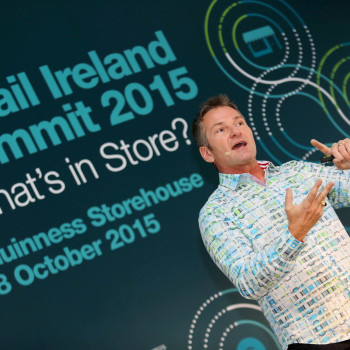
Self-styled ‘retail prophet’ Doug Stephens was in Dublin recently to outline his vision of the future for the industry. Informative, engaging and just a little bit daunting, his theories reinforce the notion that technology will rule the future, but traditional store fronts are here to stay
20 November 2015
At the world-famous Guinness Storehouse in Dublin, hundreds of executives from Ireland’s retail sector gather for the 2015 Retail Ireland Summit. The main order of business is to share ideas on the future of the industry, to discuss retailing in the digital age and to explore what the future holds for traditional bricks-and-mortar retailers in an era when anything and everything, from toothpicks to televisions, can be purchased online with ease.
With revenues from online shopping growing every year ($1.5 trillion was spent in the sector worldwide in 2014, representing a whopping 23% year-on-year growth), there is no two ways about it: traditional retailing is facing a significant threat. Online grocery shopping is set to explode in 2016 according to industry reports, and the likes of consumer electronics, music (of course) and clothing have already taken a blow due to the influence of the internet – not to mention hotels, travel agents, taxi services and more.
Does this spell the end though? Or is the threat the ‘high street’ is facing better seen as an opportunity? This is what preoccupies the Retail Ireland Summit’s keynote speaker Doug Stephens. Stephens, self-proclaimed ‘retail prophet’ and ‘retail futurist’ and author of ‘The Retail Revival: Re-Imagining Business for the New Age of Consumerism’, is a globe-trotting one-man think-tank whose theories on the future of retail suggest that the industry is undergoing a complete redefinition, just like the internet itself has in recent years. Consumer behaviour, media influence and paths to purchase have all been completely turned on their heads, leaving a once-predictable industry at sea. Some businesses thrive while others fall by the wayside and to the naked eye it’s sometimes hard to see what went wrong and what went right.
Stephens begins his engaging speech with an audacious proclamation: Retail is dead. That’s not according to Stephens himself, but tech entrepreneur Marc Andreessen.
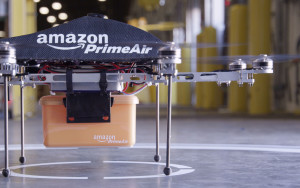
If CEO Jeff Bezos gets his way, Amazon will be able to deliver to the customer’s door by drone in the near future, according to Doug Stephens
“In fact,” according to Andreessen, “software is eating the world”.
“As you can imagine,” says Doug Stephens, “debate raged within the community, with experts coming down on either side. And when you look at the data, it’s a pretty compelling argument.”
On ‘Cyber Monday’ last year, the day after Thanksgiving in the US, when online retailers slash their prices in order to compel people to shop online, Amazon was clocking 426 sales per second. 30% of all online product searches are going through Amazon, according to Stephens. “Google used to be the cognitive default for product searches,” he says, “now it’s Amazon”.
“So then,” Stephens continues, “the challenge for e-commerce is not to get us to buy things online. We’re doing that already. The next challenge is to deliver those things in an ever-shrinking time. And we’re seeing some strange partnerships in pursuit of results to that end.
“Walmart has partnered with 7-11 in the US for ‘Grab n’Go’ lockers, eBay is delivering within the hour in major US cities and Amazon – if Jeff Bezos gets his way – will be delivering to your door by drone in the near future.”
Amazon’s much-publicised drone deliveries aren’t even a first, however. DHL and the German post office have already started delivering to remote areas by drone, while Canadian retailer Loblaw’s have joined forces with online taxi service Uber to deliver orders quicker. “Soon we’ll be at a point where if something you order online doesn’t arrive within a couple of hours, you’ll be disappointed,” says Stephens.
“In fact,” he adds with a dramatic flourish, “we may be nearing a time when they’ll be able to ship something before you even know you want it”.
Connected world
Currently there are somewhere in the region of 15bn ‘connected devices’ in the world. Stephens believes that in the next ten years that figure will swell to 50 billion as the so-called ‘internet of things’ takes hold. “Once Amazon really starts rolling out Amazon Fresh [the retailer’s grocery service],” Stephens says, “and begins delivering to households two or three times a week, the patterns become pretty robust.
“At an average grocery store,” Stephens says, “up to 50% of the items you buy are ones you don’t put any thought into. You simply replenish them. Detergent for example, or toothpaste. Eventually, buttons will exist in the home that we simply push to replenish items, which are then delivered to you. The decision process is taken out of the equation for those everyday items.”
A logical next step is that these connected appliances – your fridge or bathroom cabinet for example – detect what items need replenishing and have them delivered before you even know you need them. Existing technology, as well as the cutting edge inventions and innovations on the horizon, are set to make the online shopping experience even more convenient as well as more immersive for consumers.
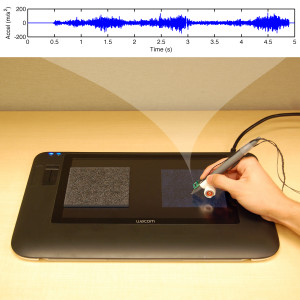
Haptography technology, currently in its early stages, is capable of replicating any texture on a highly advanced electronic surface
“Imagine instead of looking at a webpage, you will have the capability to project yourself from your couch to a store on the other side of the world,” Stephens says. “With virtual reality inventions like Oculus Rift and Google Cardboard, the potential is huge. There’s even more potential when you combine that VR with a new technology called Haptics.”
Haptography is an experimental technology in development at the University of Pennsylvania. Currently in its early stages, the technology is capable of replicating any texture on a highly advanced electronic surface. The inventor of Haptics, professor Katherine Kuchenbecher, envisions a time when a surface in the home will allow us to feel anything we see on a computer screen. Imagine buying an item of clothing online and being able to get a feel for it while you’re buying? The applications are endless.
“That’s one way e-commerce is becoming more physical,” Stephens continues. “Another way is 3D printing, which if I had brought up ten years ago you’d say I was crazy. But it’s entering the mainstream now.
“The chief operating officer of Nike said recently that he hopes to give customers the option of ‘printing’ their new Nike running shoes in the comfort of their own home,” Stephen says. “The company owns the design and sells the licence, but the customer ‘prints’ the shoe in their own home.
“These are just a couple of the ways our connected future is taking shape,” he adds.
Open all hours
If Doug Stephens’ job was to visit the Retail Ireland Summit and reassure retailers that their business is not in trouble, he’s got a funny way of going about it. Perhaps Marc Andreessen was right, and software IS eating retail?
“Are we seeing the industry disintegrate before our eyes? I’ve thought about it,” Stephens says, “and concluded that Marc is wrong. Whether it’s Roman markets of 400BC or modern shopping complexes of 2015, shopping isn’t just about ‘stuff’. Sure, there are times where you dash out to grab a product but others when it’s just about getting out with friends, being in public; it’s the ‘experience’ I’m talking about.
“If online was really the panacea Andreesen and Ted Bezos and Marc think it is, why are Amazon building physical stores? I believe it’s because they understand you can’t fully actualise as a brand until you have that emotional, visceral, physical contact with your customer; until they see your brand embodied as another human being.”
However, Stephens added, the characteristics of stores are going to change very, very dramatically over the next decade. “This is not a blip on the way back to normal,” he says. “This is the end of an era.”
The good old days
In the 20th century, the key to success in retail could defined in three broad strokes:
- Mass media was dependably effective: you could say with relative certainty how many people would see it if you put an advert on TV for your store
- Brands and retailers controlled the path to purchase: Any information on product, pricing or placement was coming from the brand or the retailer
- Physical stores were a distribution mechanism: despite inventive design or any frills, they simply existed to get the product in to the customer’s hands
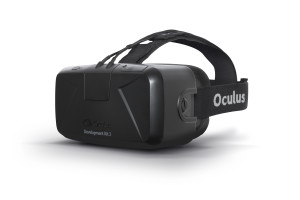
Virtual reality inventions from companies such as Oculus could have important implications for the retail sector
In retail theory, these three facts were known as the ‘purchase funnel’. It was the only way to do business, and the more money you had for marketing, the more likely you were to win the war.
But with the proliferation of online shopping and everything surrounding it, those rules no longer apply. The customer now chooses their own path to purchase. They don’t need advertisements, because social media is the only sounding board they need. “The consumer is in control,” says Stephens. He cites an experiment he did in New York City recently, where a Yankee baseball hat he ordered off eBay was delivered to him on a park bench in Madison Square, FORTY-TWO MINUTES later. “In a world where I can get a cap delivered to a park bench,” he says, “what is the purpose of a store? Here is what I think: the store will become MEDIA.
The old role of media was to tell a brand’s story, get the customer excited about a product and drive them to distribution. But now that media, be it an online ad or YouTube video or something else, is also the purchase point, it will be the store’s job to tell a brand’s story. “We have to start thinking about stores as places that provide not products, but experiences,” he says. “Sure, products will be along for the ride, but visiting a store will be about personalising, customising, co-creating and actually becoming a participant in the brand, not just an audience member as we have been for two hundred years.”
In other words, stores will become theatres surrounding the product. And far from being mere sales assistants, it will be the people in the stores’ job to be a value to it, not an expense. “They will be instruments in that theatre,” Stephens says, “brand ambassadors that love what they sell and who they sell it to.
“And there will be no debate about what they should be paid,” he adds, “because they will earn every penny.”
In closing, Doug Stephens offered a call to action to the assembled audience, challenging them to be the one to bring their brand in to the future. “YOU have to be the one to break the rules,” he says. “If an idea doesn’t scare you, it’s probably not a good one. If you don’t take risks, here’s what’s going to happen: Facebook, Apple, Amazon and the others will make themselves the centre of every consumer’s universe, and they will sell EVERYTHING.
“This is not the end of retail,” he says. “Now is a fascinating, remarkable, exciting time to be in this industry, at a time of irreplaceable opportunity: do not waste it.”



 Print
Print
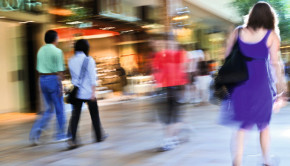


Fans 0
Followers